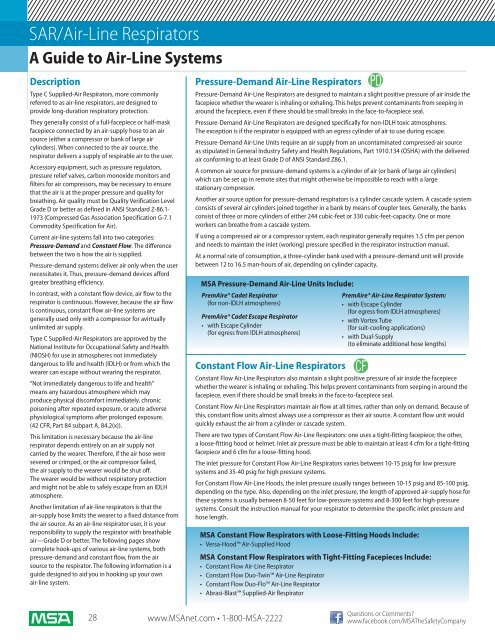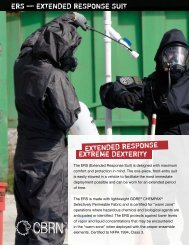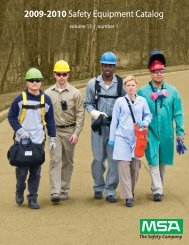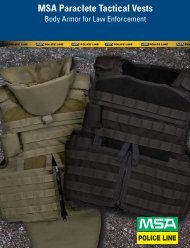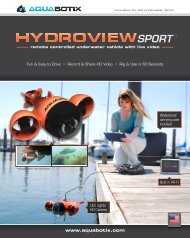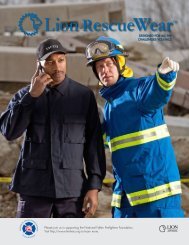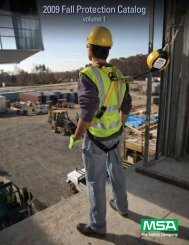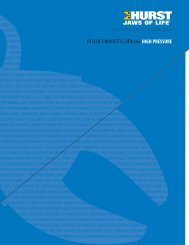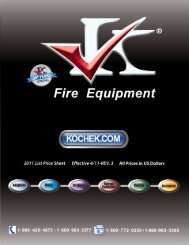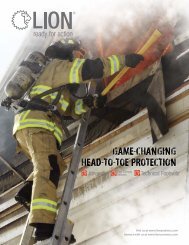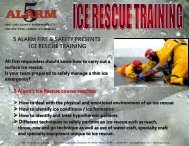Industrial Equipment Catalog - 5 Alarm Fire and Safety Equipment
Industrial Equipment Catalog - 5 Alarm Fire and Safety Equipment
Industrial Equipment Catalog - 5 Alarm Fire and Safety Equipment
- No tags were found...
You also want an ePaper? Increase the reach of your titles
YUMPU automatically turns print PDFs into web optimized ePapers that Google loves.
SAR/Air-Line RespiratorsA Guide to Air-Line SystemsDescriptionType C Supplied-Air Respirators, more commonlyreferred to as air-line respirators, are designed topro vide long-duration respiratory pro tec tion.They generally consist of a full-facepiece or half-maskfacepiece con nect ed by an air-supply hose to an airsource (either a compressor or bank of large aircylinders). When connected to the air source, therespirator delivers a supply of re spi ra ble air to the user.Accessory equipment, such as pressure regulators,pressure relief valves, carbon monoxide monitors <strong>and</strong>filters for air com pres sors, may be necessary to ensurethat the air is at the proper pressure <strong>and</strong> quality forbreathing. Air quality must be Quality Verification LevelGrade D or better as defined in ANSI St<strong>and</strong>ard Z-86.1-1973 (Compressed Gas Association Specification G-7.1Commodity Specification for Air).Current air-line systems fall into two categories:Pressure-Dem<strong>and</strong> <strong>and</strong> Constant Flow. The differencebetween the two is how the air is supplied.Pressure-dem<strong>and</strong> systems deliver air only when the usernecessitates it. Thus, pressure-dem<strong>and</strong> devices affordgreater breathing efficiency.In contrast, with a constant flow device, air flow to therespirator is continuous. However, because the air flowis continuous, constant flow air-line systems aregenerally used only with a compressor for avirtuallyunlimited air supply.Type C Supplied-Air Respirators are approved by theNational Institute for Occupational <strong>Safety</strong> <strong>and</strong> Health(NIOSH) for use in atmospheres not immediatelydangerous to life <strong>and</strong> health (IDLH) or from which thewearer can escape without wearing the respirator.“Not immediately dangerous to life <strong>and</strong> health”means any haz ard ous atmosphere which mayproduce physical discomfort immediately, chronicpoisoning after repeated exposure, or acute adversephysiological symptoms after prolonged exposure.(42 CFR, Part 84 subpart A, 84.2(x)).This limitation is necessary because the air-linerespirator depends entirely on an air supply notcarried by the wearer. Therefore, if the air hose weresevered or crimped, or the air compressor failed,the air supply to the wearer would be shut off.The wearer would be without respiratory protection<strong>and</strong> might not be able to safely escape from an IDLHatmosphere.Another limitation of air-line respirators is that theair-supply hose limits the wearer to a fixed distance fromthe air source. As an air-line respirator user, it is yourresponsibility to supply the respirator with breathableair—Grade D or better. The following pages showcomplete hook-ups of various air-line systems, bothpressure-dem<strong>and</strong> <strong>and</strong> constant flow, from the airsource to the respirator. The following information is aguide designed to aid you in hooking up your ownair-line system.Pressure-Dem<strong>and</strong> Air-Line RespiratorsPressure-Dem<strong>and</strong> Air-Line Respirators are designed to maintain a slight positive pressure of air inside thefacepiece whether the wearer is inhaling or exhaling. This helps prevent contaminants from seeping inaround the facepiece, even if there should be small breaks in the face-to-facepiece seal.Pressure-Dem<strong>and</strong> Air-Line Respirators are designed specifically for non-IDLH toxic atmospheres.The exception is if the respirator is equipped with an egress cylinder of air to use during escape.Pressure-Dem<strong>and</strong> Air-Line Units require an air supply from an uncontaminated compressed-air sourceas stipulated in General Industry <strong>Safety</strong> <strong>and</strong> Health Regulations, Part 1910.134 (OSHA) with the deliveredair conforming to at least Grade D of ANSI St<strong>and</strong>ard Z86.1.A common air source for pressure-dem<strong>and</strong> systems is a cylinder of air (or bank of large air cylinders)which can be set up in remote sites that might otherwise be impossible to reach with a largestationary compressor.Another air source option for pressure-dem<strong>and</strong> respirators is a cylinder cascade system. A cascade systemconsists of several air cylinders joined together in a bank by means of coupler tees. Generally, the banksconsist of three or more cylinders of either 244 cubic-feet or 330 cubic-feet-capacity. One or moreworkers can breathe from a cascade system.If using a compressed air or a compressor system, each respirator generally requires 1.5 cfm per person<strong>and</strong> needs to maintain the inlet (working) pressure specified in the respirator instruction manual.At a normal rate of consumption, a three-cylinder bank used with a pressure-dem<strong>and</strong> unit will providebetween 12 to 16.5 man-hours of air, depending on cylinder capacity.MSA Pressure-Dem<strong>and</strong> Air-Line Units Include:PremAire® Cadet Respirator(for non-IDLH atmospheres)PremAire® Cadet Escape Respirator• with Escape Cylinder(for egress from IDLH atmospheres)Constant Flow Air-Line RespiratorsPremAire® Air-Line Respirator System:• with Escape Cylinder(for egress from IDLH atmospheres)• with Vortex Tube(for suit-cooling applications)• with Dual-Supply(to eliminate additional hose lengths)PD CFPD CFConstant Flow Air-Line Respirators also maintain a slight positive pressure of air inside the facepiecewhether the wearer is inhaling or exhaling. This helps prevent contaminants from seeping in around thefacepiece, even if there should be small breaks in the face-to-facepiece seal.Constant Flow Air-Line Respirators maintain air flow at all times, rather than only on dem<strong>and</strong>. Because ofthis, constant flow units almost always use a compressor as their air source. A constant flow unit wouldquickly exhaust the air from a cylinder or cascade system.There are two types of Constant Flow Air-Line Respirators: one uses a tight-fitting facepiece; the other,a loose-fitting hood or helmet. Inlet air pressure must be able to maintain at least 4 cfm for a tight-fittingfacepiece <strong>and</strong> 6 cfm for a loose-fitting hood.The inlet pressure for Constant Flow Air-Line Respirators varies between 10-15 psig for low pressuresystems <strong>and</strong> 35-40 psig for high pressure systems.For Constant Flow Air-Line Hoods, the inlet pressure usually ranges between 10-15 psig <strong>and</strong> 85-100 psig,depending on the type. Also, depending on the inlet pressure, the length of approved air-supply hose forthese systems is usually between 8-50 feet for low-pressure systems <strong>and</strong> 8-300 feet for high-pressuresystems. Consult the instruction manual for your respirator to determine the specific inlet pressure <strong>and</strong>hose length.MSA Constant Flow Respirators with Loose-Fitting Hoods Include:• Versa-Hood Air-Supplied HoodMSA Constant Flow Respirators with Tight-Fitting Facepieces Include:• Constant Flow Air-Line Respirator• Constant Flow Duo-Twin Air-Line Respirator• Constant Flow Duo-Flo Air-Line Respirator• Abrasi-Blast Supplied-Air Respirator28www.MSAnet.com • 1-800-MSA-2222Questions or Comments?www.facebook.com/MSAThe<strong>Safety</strong>Company


